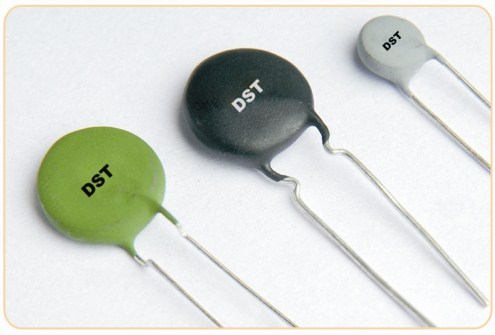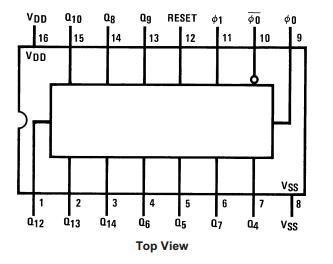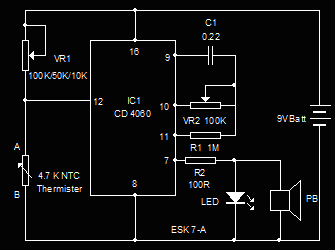This is the circuit of a Heat sensor that beeps when it detects heat. It is an ideal add on circuit in heat generating devices like Inverter and Amplifier.
Thermister is a special kind of resistor and its resistance depends on the temperature in its vicinity, Depending on its working, thermistors are divided into two types: Positive Temperature Coefficient thermistors (PTC) and Negative Temperature Coefficient thermistors (NTC).
PTCs tend to increase their resistance as per the temperature increments while NTCs’ resistance reduces down with the temperature rise. The circuit mentioned here uses NTC thermistor.In cold, the NTC Thermister offers high resistance and its resistance decreases to a few ohms when the temperature near it increases.

Apart from the NTC thermistor, this circuit also uses a CD4060 IC which is a ripple carry binary counter.

The Thermister is connected to the points A and B. When the temperature is normal, it offers high resistance and gives a high voltage to the pin 12 of IC1. It is a binary counter that becomes active only when its reset pin 12 is low. So in the standby state, IC will not work and alarm generator remains silent. Variable resistor VR1 adjusts the sensitivity of the Thermister at the particular temperature level. When there is fire or heat in front of the Thermister, the resistance of the Thermister decreases and it becomes conducting. This takes the reset pin 12 of IC1 to ground and it starts oscillating. The oscillations of IC1 generate beeps through the buzzer along with LED blinking. VR2 can be adjusted to get slow to fast beep rates and flash rate of LED.
Adjust VR1 till the buzzer stops beeping at the normal temperature inside the case of gadget. If a POT is used as VR1 it is easy to set the working of IC from outside.
Circuit Diagrams
Filed Under: Electronic Projects



Questions related to this article?
👉Ask and discuss on Electro-Tech-Online.com and EDAboard.com forums.
Tell Us What You Think!!
You must be logged in to post a comment.